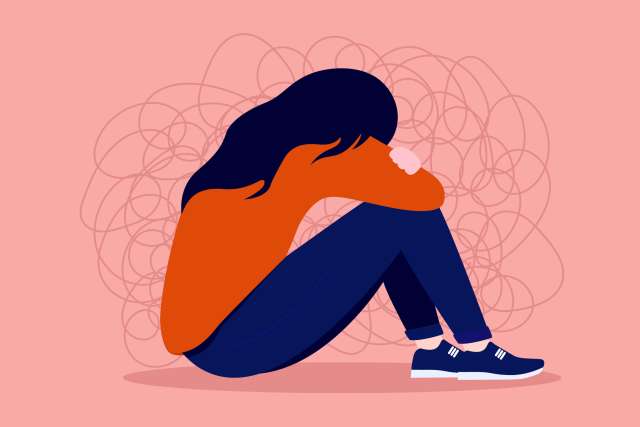More than half of teen girls feel “persistently sad or hopeless” — the highest level reported in a decade — according to the .
One in five girls experienced sexual violence in the past year, the CDC says, and one in three seriously contemplated attempting suicide.
“I’ve talked to thousands of girls around the country, and they tell me that they feel like their lives today are one endless performance,” says Donna Jackson Nakazawa, author of “Girls on the Brink: Helping Our Daughters Thrive in an Era of Increased Anxiety, Depression and Social Media.” “They are performing to be liked and followed online, they are performing at school, and they are exhausted.”
Nakazawa and UCLA Health child and adolescent psychiatrist discussed girls’ mental health challenges during a recent virtual “” program presented by the .
One in three girls experience symptoms of depression, compared to one in 10 boys, studies show. Researchers are still trying to understand the greater prevalence of depression in girls, Nakazawa says. Part of the problem is that, until 2016, neuroscientists only looked at the male brain’s response to stress. They’ve since learned that stress affects male and female brains differently.
Dr. Gillis confirms that more girls present with depression symptoms than boys at UCLA Health clinics and emergency departments.
So many stressors
Young people today face stressors to an extreme that past generations didn’t, Nakazawa says. Climate change, political polarization, hate crimes and school shootings are commonplace concerns for children.
“There’s this sense of unsafety that kids feel,” she says, “and they feel it when they’re online and they feel it when they’re offline.”
As these pressures have increased, in-real-life connections have decreased — both among teens with their peers, and among families with their communities.
“This generation is spending less time than any other generation face-to-face with their friends,” Nakazawa says.
Compounding challenges for girls is earlier onset of puberty and the way female brains process stress, particularly chronic stress. Puberty stimulates the release of estrogen, and estrogen activates “stress machinery” in a way that testosterone doesn’t, Nakazawa says.
With puberty starting earlier for girls, “estrogen is coming in at a time when we don’t really want to see the brain get remodeled,” she says. “Those parts of the brain that know how to analyze thoughts and feelings and distress haven’t wired and fired up yet.”
Earlier puberty onset also leads to increased sexualization of girls, and what Nakazawa describes as a “blurring of lines” between childhood and adult female sexuality.
Girls “come to feel that nothing is of value in them in our society except this way of being seen as a grown adult sexual being when they’re still children,” she says.
Parents may not always recognize that their daughters are struggling.
“If you’re asking the question internally, it’s time to ask someone externally instead of assuming it’s probably normal development,” Dr. Gillis says. “Parents often make that assumption, especially if it’s the oldest daughter or the oldest child… . But if you’re asking the question internally, it’s time to ask a pediatrician or a therapist.”
What can parents do?
- Have conversations with their daughters, and do more listening than talking.
Studies show that when parents listen without asking questions, kids share more, Nakazawa says: “They’re more likely to feel that you’re on their side and more likely to come to you next time.”
Having a parent or other adult they can discuss challenges with is a key factor in teen well-being, she says: “The chance of a teen flourishing is 12 times higher when a teen feels they can turn to a parent with anything, no matter how hard.”
It’s important for parents to calm themselves before and during these tough conversations, she adds, because children “borrow their neurobiology from us” and will unconsciously pattern their breathing after ours.
Finally, she and Dr. Gillis suggest thanking your daughter for having the conversation and letting her know how much it means to you to connect.
“Positive reinforcement is much stickier and more effective than negative reinforcement,” Dr. Gillis says.
- Validate your daughter’s experiences.
Avoid judging her behavior or rushing in to “fix” things. Instead, when she shares a challenging experience or uncomfortable feelings, respond with something like, “That sounds really hard. Anyone in your shoes would feel the same way you do,” Nakazawa suggests.
- Teach and model social media literacy.
It’s not enough to talk to kids about curbing their scrolling habits. Parents should also embody this behavior themselves, Nakazawa and Dr. Gillis say, adding that intimate conversations are less likely when parent or child has their phone in hand.
It’s also important to discuss how all that scrolling makes us feel, Dr. Gillis says.
“Teaching your kids to pay attention to how they feel when they’re on social media is an important skill to teach as they go through adolescence and emerge into adulthood,” she says. “That’s what’s going to be helpful as they make decisions about how they engage with social media and other things they’re involved in.”
- Try talking in the car, and listen with your heart.
Some teens might be reticent during face-to-face conversations, Dr. Gillis says. It can be helpful to discuss more challenging subjects while in the car, where parent and child may be side by side but not looking directly at each other. Similarly, it might be more comfortable to have hard conversations while on a walk together.
Another tip that can help parents, Nakazawa says, is to imagine listening with an open heart.
It’s about what you feel as you communicate with your kids, she says: “We have to be listening with the heart first. It can help just to imagine that your heart is connecting with your child’s, and everything will come from there.”




